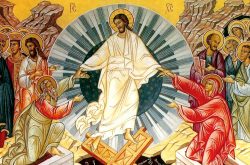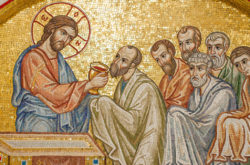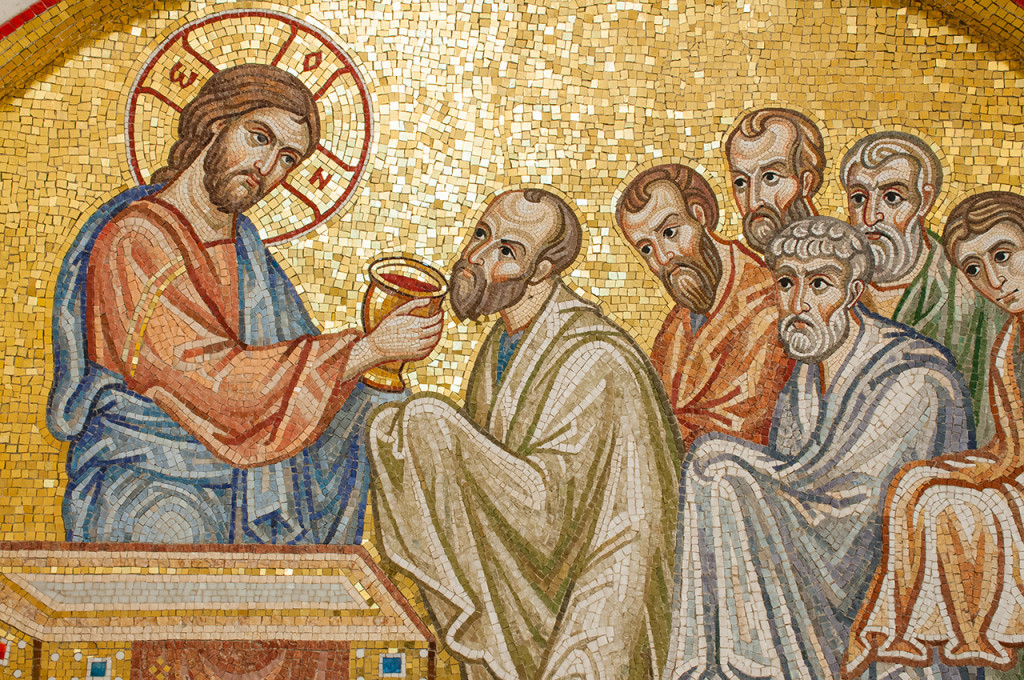初期教父時代(The Early Patristic Period)
宗徒時期後期(從第一世紀末至第三世紀初)的基督教靈修,其構成元素主要可以歸納為以下幾點:(1)以聖餐為根本的教會結構逐漸形成(2)教父們為了反駁諾斯替教派(Gnosticism)而做出的回應(3)基督教式的諾斯替教派(Christian Gnosticism)的出現,以及它在靈修上的重要性(4)以殉道(martyrdom)作為一種靈修形式,也作為對孟他努派靈修(Montanist spirituality)的回應。
教會結構
靈修的內涵與架構,主要以「聖餐禮儀」為軸心,並且受到Ignatius(Antioch的主教, d. 110 C.E.)所提出的「教會結構」所影響。Ignatius在他的七封書信(此七封書信留存兩個版本,一個是內文較長的版本,一個較短,其中,簡短版普遍受大眾認可)當中,提出了一個令人信服的有力觀點,他認為,救贖、靈修或永生只有透過虔誠的參與聖餐禮儀,與基督的身體合而為一才能夠實現。並且,這個身體在教會的全體中形成,藉由主教(也就是聖餐禮儀的主持者)、諸位長老還有執事們的協助,將所有的信徒聚集起來。Ignatius堅稱,除非一個人持續不斷的參與以聖餐禮儀為主軸的團體,並且服從於此團體的領導者—-主教,否則不可能領受上帝所賜與的永生。
乍看之下,Ignatius的這些觀點似乎是將「聖餐主義」(sacramentalism)以一種異教徒或是變魔法的方式引進「靈修」當中,也像是一種遵從神職體系下的絕對權威的教條主義,要求所有教會信徒無論在何種情況下都要絕對的服從。Ignatius把聖餐禮儀稱為「永生的良藥,死亡的解藥」(Letter to the Ephesians 20.2)也因為如此,有學者認為,我們的靈修是異教的靈修,完全偏離聖經的思想。我想,這樣的結論是十分輕率而不公平的。Ignatius並沒有將聖餐視為一個具有永生的超自然力量之物。對他來說,聖餐禮儀基本上是一個相互融合的事件,是一種在同一信念中的結合(synaxis),與最早期末世論所提出的「當基督再來時(parousia)將分散在各處的上帝的子民結合在一起」。因此,Ignatius神學當中所說的「永生的良藥」意義是「永恆的生命並非來自於聖餐本身,而是來自於我們參與了這個結合,與這個團體合一」。
在這裡,我們也必須瞭解,Ignatius強調我們如果想要參與永恆的生命,主教是不可或缺的要素。違背主教的人,就等於違背了上帝和基督—-教會真正的主教。因為主教代替上帝來行事,是上帝的代表。對Ignatius來說,永恆和真正的生命是一個具有末世意義的事實,只有參與具有末世意義的團體才能實現,永恆的生命也預先展現在聖餐禮儀的共融當中。它的意義在於「救贖不是個人的事件,而是所有上帝的子民共同成就的事件」,這樣的想法與聖經的根本思想完全一致。那些蔑視聖餐禮儀和禮儀的主持者—-主教的人是自大的,他們的作法將切斷他們與「永恆生命」和「上帝」的連結。主教的重要性在於他是聖餐共同體的領導者,而不在於他個人所掌握的職務。就像聖餐(麵包與酒)一樣,主教制度只不過是一個相關的媒介,對於靈修生活來說,這兩個項目都是十分重要的,因為它們對於末世團體由古自今的存在意義重大。Ignatius所提出的聖餐禮儀的神秘主義基本上是與聖經意義相符合的,它保留了末世論的思潮和教會團體的基礎,指出聖經裡的靈修生活之道。
Ignatius’s views continued to dominate the church’s life in the first centuries as is evident from other documents, such as the Syriac Didascalia Apostolorum from the beginning of the third century and the Apostolic Tradition (Traditio apostolica) of Hippolytus of Rome from about the same period. Both of these documents, which served as the basis for the development of church structure and life for many centuries, stress the principle that the eucharistic community and its head, the bishop, constitute the inevitable context of Christian spirituality. No one can participate in eternal life without passing through the Eucharist and the bishop. This idea led to the axiom “No salvation outside the church” (extra ecclesiam nulla salus), which we encounter in Origen and Cyprian and which seems to be presupposed throughout the early church. This axiom was misunderstood later on as implying institutionalism and legalism. In the first centuries, however, ecclesia (church) still meant the same thing as in Paul’s letters to the Corinthians, namely, the actual eucharistic gathering. It should be paraphrased, therefore, as follows: without participation in the eucharistic communion there is no salvation. This is another way of saying what the Fourth Gospel stresses–that unless we eat the flesh and drink the blood of the Son of Man we cannot have life; but according to the same Gospel it is the Spirit that gives life, and therefore it is the communion and the community of the Spirit, the church, that offers the context of spiritual life. The bishop is essential, since he is the head of this eucharistic community.
On the basis of such an interpretation it becomes evident that it was a fundamental assumption throughout the early church that only one Eucharist and only one bishop could exist in the same place. Since the bishop is important not as an individual but as the head of the eucharistic community and since the Eucharist is not a sacrament but the manifestation of the eschatological community in its totality, more than one bishop and more than one Eucharist would signify more than one church in a certain place. Ignatius and Cyprian were very strict on this matter, and so was the First Ecumenical Council, the Council of Nicaea, in 325 C.E., the eighth canon of which forbids the existence of more than one bishop in the same city.
The spiritual significance of this canonical provision is extremely profound. As we have already noted, the Eucharist is the place where all divisions, whether of a natural or a social kind, are transcended in the unity of Christ, in whose kingdom such divisions amounting to death will disappear. If the church celebrates a special Eucharist for the children or for the adults or for men or for women or for black or for white people, etc., this would lead to an eschatological affirmation of these natural divisions. The same would be true if there were special eucharistic celebrations for ethnic groups, professions, or social classes. In the Eucharist one must learn to accept all other human beings as belonging to the same body and sharing the same ultimate destiny. It is this profound “horizontal” dimension that the principle “one Eucharist, one bishop, one church” seeks to keep alive in spirituality. It is not enough to keep a so-called spiritual (in the sense of nonmaterial) unity with other people. True Christian spirituality requires an actual bringing together–indeed, a material and historical experience of unity. Unless there is one concrete community and one head/bishop of this community, there is no spiritual experience that is, properly speaking, Christian.
This principle–one Eucharist, one bishop, one church–was maintained even when practical necessities, such as the rapid increase in the number of Christians from the late third century on, forced the church to create parishes and thus assign the role of eucharistic leadership to presbyters. It was a serious deviation from original ecclesiology to regard the bishops primarily as administrators of large dioceses and the presbyters as the celebrants of the Eucharist. This took place in the Middle Ages, but in the fourth century the bishop was still the eucharistic president. The presbyters acted in the Eucharist always on the bishop’s behalf and with his explicit permission. For a long time, especially in the West, the bishop would send a portion of his Eucharist to the parishes in order to mix it with the presbyter’s Eucharist and thus make real the idea that there is only one Eucharist in each place, that of the bishop. This practice was known as fermentum. In the East what prevails even today is the practice of the antimension, a piece of cloth containing relics of saints (a sign of unity of the church in time) as well as the signature of the local bishop, which affirms that it is the bishop that makes the parish Eucharist valid, that there is only one Eucharist in each place.
Finally, the stress on the central and crucial importance of the actual and not simply the symbolic celebration of the Eucharist signifies that Christian spirituality is not based on contempt for or depreciation of matter. The Eucharist involves eating and drinking, that is, a meal. It also involves material elements, bread and wine, as well as human labor. All of these are sanctified in the Eucharist. Unlike ancient Greek, and especially Neoplatonic attitudes to spirituality, the patristic mentality, based on a eucharistic approach to life, stressed that being “spiritual” meant accepting and sanctifying the material world and not undermining its importance in any way. This point was particularly stressed by Irenaeus, bishop of Lyons (b. 140-160), and it was developed as an argument against the Gnostics. But on this we shall say more below.


